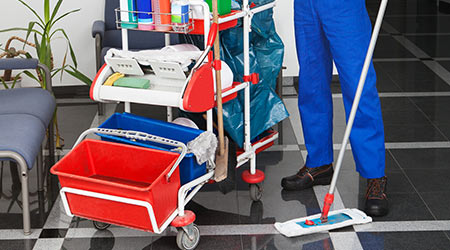
The janitor cart can be an effective tool for cleaning any type of facility or it can be a disaster.
I have encountered carts that looked more like food stands due to the personal items and disorganization. One cart was full of various chemical containers (unnumbered and some unlabeled), three bowl swabs, two dusters, a quart of 26 percent-acid bowl cleaner, a buffing pad, multiple soiled rags, two rolls of toilet tissue that had evidence of water damage, four soap cartridges, two hot dogs, a soda, chips, a makeup kit and a purse.
When I mentioned this janitor cart to the supervisor, he responded that each worker had the right to customize their cart as they saw fit so long as they got the job done.
My first challenge was to educate the supervisor on the value of having a clean, well-organized cart that enabled the worker to be productive while also being safe.
Food and personal items should not be allowed on a cart at any time. Failing to maintain the cart with only the necessary products to be used that shift is simply not following custodial best practices.
The following is a suggested list of items for a typical janitor cart that would be used in zone cleaning. Note that this list will vary based on the requirements at different sites, so adjust as necessary.
• Full containers for glass cleaner, all-purpose cleaner, disinfectant, bowl cleaner (for restrooms) and polish (optional). All chemical containers should be color-coded, labeled and numbered.
• Optional chemicals include mild buffered acid cleaners for mineral deposits, deodorizers and mild abrasive cleansers for occasional use.
• Chemicals not to include on the cart: bleach, pine scent, ammonia, bowl acids or anything not needed.
• Cleaning cloths (can be disposable wipes, microfiber, cotton or a combination) that are clean. There should be enough to complete the shift without cross-contamination.
• A swab for cleaning toilets.
• A clean lambswool duster with an extension handle to reach vents.
• A sufficient amount of consumable products, such as toilet tissue, paper towels and hand soap.
• A sufficient amount of replaceable products such as can liners.
• A clean double bucket and wringer combination with microfiber mop heads that can be replaced after a predetermined number of uses.
• A plastic angle broom and dust pan. Both of which should be cleaned regularly.
• Each cart should have its own set of Safety Data Sheets readily available for all products in the cart.
• Optional products: notepad/pencil, inspection mirror and other similar tools.
For smaller routes that cannot accommodate a full-size custodial cart, building service contractors should provide their janitors with caddies or utility buckets that allow workers to carry the cleaning chemicals, swabs and cloths safely without possibility of spillage. A major source of carpet damage can be traced to workers carrying damp bowl swabs or leaking bottles that can ruin carpets in seconds.
A well-stocked, properly set-up cart that allows the worker access to products (think rolling janitor closet), as well as tools and other supplies, can increase productivity, enhance results and reduce complaints.
Charles “Mickey” Crowe has been involved in the cleaning industry for over 35 years. He is currently a trainer, speaker, consultant and contributor to Contracting Profits’ website, www.cleanlink.com.

 The Down and Dirty on Cleaning in Virus Season
The Down and Dirty on Cleaning in Virus Season How Surfactant Use is Expanding in Commercial Cleaning
How Surfactant Use is Expanding in Commercial Cleaning Maximize Your Margins: Learn How to Automate Pricing and Track Rebates
Maximize Your Margins: Learn How to Automate Pricing and Track Rebates